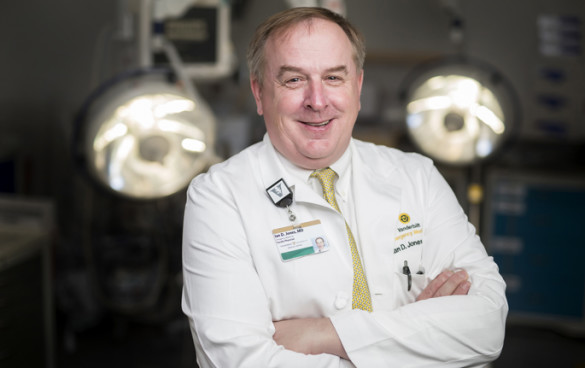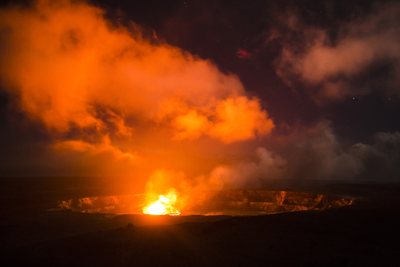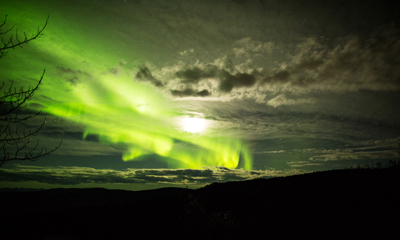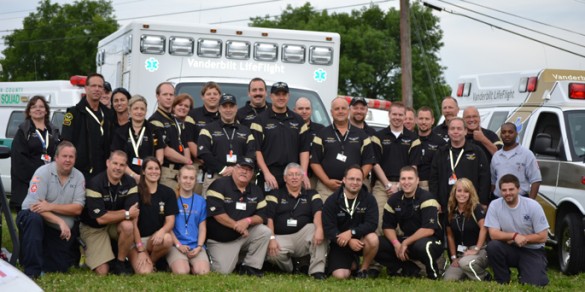
Last May, Ian Jones, M.D., associate professor of Emergency Medicine and executive medical director of Emergency Services at Vanderbilt University Medical Center, stopped in his tracks when news reports flashed about lava overflowing the crater lake at the summit of the Kilauea volcano in Hawaii.
He knew he needed to get there, fast — with his camera.
“It was probably the craziest thing I ever did,” chuckled Jones. “I remember asking my wife if it was OK to go, using my frequent flier miles that were nearing expiration, and arriving in Hawaii right around midnight.”
Jones was one of several photographers who captured the eruption and its aftermath.
“It was the first time that the lava lake has been visible in the crater since the 1920s. I was there only a day and a half and it was so worth it.”
His time-lapse video of the lava flowing onto the crater floor was featured on Hawaii’s Volcanoes National Park Facebook page.
Over the course of 30 years, Jones has witnessed intense, inexplicable and miraculous marvels — both on the frontlines of medicine and behind the lens of a camera. He has been published in prestigious medical journals like the New England Journal of Medicine and the Journal of the American Medical Association — but not for his clinical observations.

“I’ve had a picture of a volcanic eruption (Eyjafjallajökull) in Iceland published in one and a photo of the sunset over the Serengeti Plains in another,” he said. “I have never excelled at research, so being fortunate to have a picture published in major journals is my claim to fame!”
Early on Jones showed a desire for varied experiences.
An avid soccer player until recently, Jones still holds both the Rhodes College and the Collegiate Athletic Conference career scoring record. His jersey remains the only men’s soccer jersey retired at Rhodes. He briefly considered playing professionally after he finished college.
“Back then, it never really crossed my mind that soccer could have been more for me,” he said. “Most of the people who were really good had come from Europe and I don’t think I had near that level of talent.”
Jones always had a strong interest in science. An anthropology/sociology major, he graduated from Rhodes in 1986 with plans to get a second degree in geology with a goal of becoming a paleontologist.
The following year he studied vertebrate paleontology and spent most of his time in the field digging for dinosaurs at the University of New Mexico in Albuquerque.
Discovering that paleontology was a better hobby than a career, he returned home planning to attend medical school. He earned an additional degree in biology from the University of Tennessee and went on to earn his medical degree with honors from the UT Center for Health Science in 1993.
He completed his residency at Vanderbilt and served as chief resident in 1997. He joined the Vanderbilt faculty in 1998.
“I didn’t take the straight path into medicine by any means,” said Jones. “But it is all a part of my experience. I really enjoy the ED because of the variability and varied complexities of patient presentation and acuity.
“I like the pace and the flexible schedule that allows me to indulge in all of my hobbies — photography, diving, caving, skiing. You have to be careful in emergency medicine,” he said. “It’s a high-paced specialty with one of the highest burnout rates in the country. You have to find balance and things outside of your work to recharge your batteries.”

One of his favorite hobbies is night photography, especially landscapes featuring the Milky Way. He recently visited Greenland, capturing live video of the Northern Lights “dancing above massive icebergs drifting out to sea.” Jones shot the natural phenomenon, also known as the Aurora Borealis, in temperatures registering 10 degrees below zero.
Much like his hobbies, his medical interests are varied. He counts the development of the ED Whiteboard as one of his biggest achievements.
“We began working on the Whiteboard around 2000, in an era where we were still using paper charts and a dry erase tracking board,” recalled Jones. “Over the years, everything has gone electronic and we have been expanding the system’s capabilities and functionality ever since.”
At Vanderbilt, a varied team of physicians, nurses, registration and support staff collaborated with the Department of Biomedical Informatics to provide feedback and help customize the system to fit individual workflows, said Jones.
“It’s as if we had a full-time staff of consultants for free.”
He is grateful that he has been given the opportunity to find his niche in Informatics and encourages others to discover areas where they can become experts.
Corey Slovis, M.D., professor and chair of Emergency Medicine, said Jones is unique and a consummate team leader.
“Ian is one of the true heroes,” said Slovis. “What he has done with our electronic whiteboard has been to get input from everyone — faculty, physicians, residents, nurses, registration staff — and has incorporated the best ideas into an ever-improving product.
“He is able to combine his interpersonal strengths with his expertise in informatics along with his experience at being an astute treating physician. It’s very unusual to have such an expert in informatics be such an expert and active clinician.”
Jones, who is also an associate professor of Biomedical Informatics, said working in an academic center helps create an atmosphere for learning and an environment to collaborate on techniques to approach medicine in general.
“When you work alongside people like that, it tends to rub off on you,” said Jones. “Someone can always teach you something if you are ready to learn. I am one who believes that you can never learn enough.”
Jones’s penchant for technology is the driving force behind his career aspirations.
“My ultimate career goal would be to utilize evidence-based practice along with informatics tools to help standardize emergency care in other hospitals,” he said.
“As we grow our network, it would be my desire to bring Vanderbilt’s expertise in emergency medicine and our interfaces with specialty care to all the hospitals in the network.
“We have worked really hard to develop protocols and pathways in collaboration with many departments throughout the hospital and we could share that focused collaboration with hospitals in the community that are not fortunate enough to have the wide spectrum of specialties we offer.”
While his career objectives keep him close to home, his photography takes him thousands of miles away.
Atop his bucket list — venturing to Antarctica and returning to Africa.
“Antarctica has always been at the top of my list,” he said. “I went to Africa 10 years ago, but I want to return to primarily shoot wildlife. For me, one is cool because it’s cold and the other is just plain cool.”















